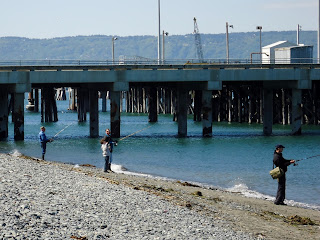Our final night was spent in Ketchikan, once declared the most disgraceful, vice-riddled city in America (no doubt due to the twenty or so brothels lining Creek Street, as well as the open alcohol consumption and gambling during the Prohibition).
A view of Creek Street and some of the surviving houses of ill-repute,
re-purposed as shops.
For those who venture farther into the town, be prepared for a good walk. In my last post, I mentioned that these islands are not flat, and nowhere is that more apparent than Ketchikan.
What passes for a sidewalk in this town.
In fact, those parts of the town that aren't built over the water are built up the sides of hills so steep, in one case a trolley was installed for pedestrians.
(Note the trolley and track behind the totem pole)
A creative approach to reaching the front door.
The town even added a fish ladder to help the salmon up Ketchikan Creek.
(though most likely for other reasons than the steepness, but still...)
As an interesting side note, the hotel we stayed at was called the Inn at Creek Street / New York Hotel. The Inn at Creek Street seemed self-explanatory, but not the New York part. Turned out this hundred-year-old hotel was originally owned by Japanese immigrants (a not uncommon ethnic group in old Alaska) who immigrated through Ellis Island (no idea how they ended up there) and then settled in Ketchikan (which is about as far from New York as one could get). They were so pleased to be in America they named their hotel after the first city they stayed in. Being a fan of old historic buildings, I loved this hotel with all its antiques and period furnishings.
The bedside stand, right out of the '40's!
(Inn at Creek Street/ New York Hotel)
And last, but not least, one of the real reasons I loved this town? A friendly feline (and only the second one I saw on the entire trip through Alaska, besides the mayor of Talkeetna).
And so ends my trip through Alaska, and nearly three weeks of paradise.
If you have any thoughts or comments, feel free to post a comment below or email me at ellen.lindseth@gmail.com.




























































